

Zhuangzi. The Zhuangzi (also known in Wade-Giles romanization romanization as Chuang-tzu), named after “Master Zhuang” was, along with the Laozi, one of the earliest texts to contribute to the philosophy that has come to be known as Daojia, or school of the Way.
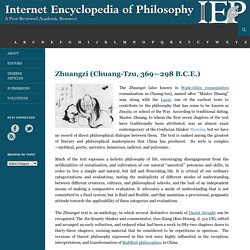
According to traditional dating, Master Zhuang, to whom the first seven chapters of the text have traditionally been attributed, was an almost exact contemporary of the Confucian thinker Mencius, but we have no record of direct philosophical dialogue between them. The text is ranked among the greatest of literary and philosophical masterpieces that China has produced. Zhuangzi. Laozi (Lao-tzu) Laozi is the name of a legendary Daoist philosopher, the alternate title of the early Chinese text better known in the West as the Daodejing, and the moniker of a deity in the pantheon of organized “religious Daoism” that arose during the later Han dynasty (25-220 C.E.).
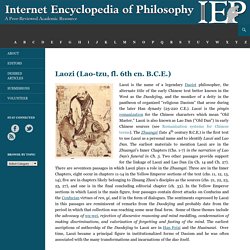
Laozi is the pinyin romanization for the Chinese characters which mean "Old Master. " Laozi is also known as Lao Dan ("Old Dan") in early Chinese sources (see Romanization systems for Chinese terms). The Zhuangzi (late 4th century B.C.E.) is the first text to use Laozi as a personal name and to identify Laozi and Lao Dan. The earliest materials to mention Laozi are in the Zhuangzi’s Inner Chapters (Chs. 1-7) in the narration of Lao Dan’s funeral in Ch. 3. Two other passages provide support for the linkage of Laozi and Lao Dan (in Ch. 14 and Ch. 27). The Taoist Path. The Taoist Path Introduction. © Jonathan Zap. 2004 back to Zap Pavilion Someone once described stories as "equipment for living.

" Quality fiction does fit that definition and, of course, so does the right non fiction. The modern Taoist quotes presented here are almost the illustration of this definition. Tao Te Ching - Translated by J. Legge. The Tao that can be trodden is not the enduring and unchanging Tao.
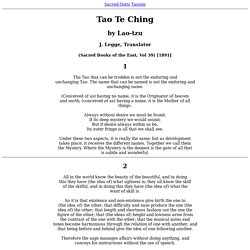
The name that can be named is not the enduring and unchanging name. (Conceived of as) having no name, it is the Originator of heaven and earth; (conceived of as) having a name, it is the Mother of all things. Always without desire we must be found, If its deep mystery we would sound; But if desire always within us be, Its outer fringe is all that we shall see. Under these two aspects, it is really the same; but as development takes place, it receives the different names. Taoism - What is Te. What is Te?
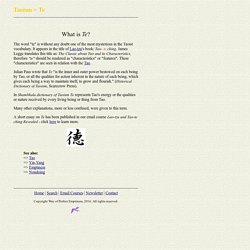
The word "te" is without any doubt one of the most mysterious in the Taoist vocabulary. It appears in the title of Lao-tzu's book: Tao- te ching. James Legge translates this title as: The Classic about Tao and its Characteristics, therefore "te" should be rendered as "characteristics" or "features". These "characteristics" are seen in relation with the Tao. Julian Pass wrote that Te "is the inner and outer power bestowed on each being by Tao, or all the qualities for action inherent in the nature of each being, which gives each being a way to maintain itself, to grow and flourish.
" In Shambhala dictionary of Taoism Te represents Tao's energy or the qualities or nature received by every living being or thing from Tao. Many other explanations, more or less confused, were given to this term. Taoism. Taoist rite at the Qingyanggong (Bronze Ram Temple) in Chengdu, Sichuan.

Taoism, or Daoism, is a philosophical, ethical, and religious tradition of Chinese origin that emphasizes living in harmony with the Tao (also romanized as Dao). Taoism - What is Te. Pennsylvania Echoes. In the ancient philosophy of Taoism,

Tao Te Ching - Lao Tzu - A Comparative Study. Chuang Tzu Index. Taoism. CenterTao.org. Traditional, Philosophical Ways The Tao Te Ching (the core Taoist scripture) invites you to contemplate your innermost sense of reality.
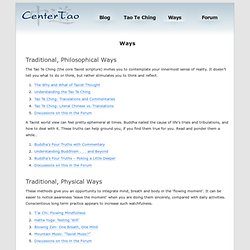
It doesn’t tell you what to do or think, but rather stimulates you to think and reflect. A Taoist world view can feel pretty ephemeral at times. Buddha nailed the cause of life’s trials and tribulations, and how to deal with it. These truths can help ground you, if you find them true for you. Traditional, Physical Ways These methods give you an opportunity to integrate mind, breath and body in the ‘flowing moment’. Contemporary, Philosophical Ways. Taoism - The Wu-Wei Principle - Part 4. This unceasing flow of change manifests itself as a natural order governed by unalterable, yet perceivable laws.
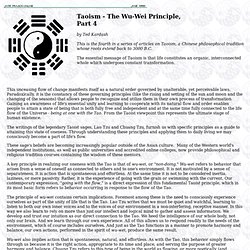
What is Yin Yang? - Personal Tao. A starting definition: The nature of change, balanced as two halves of a whole.
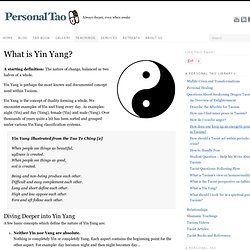
Yin Yang is perhaps the most known and documented concept used within Taoism. Yin Yang is the concept of duality forming a whole. We encounter examples of Yin and Yang every day. As examples: night (Yin) and day (Yang), female (Yin) and male (Yang). Over thousands of years quite a bit has been sorted and grouped under various Yin Yang classification systems. Yin Yang illustrated from the Tao Te Ching [2]When people see things as beautiful, ugliness is created. Diving Deeper into Yin Yang. Wu Wei and “moving with the flow” « Pennsylvania Echoes. There are a couple distinctions in Taoist philosophy,: The Subjective: The way people interpret and describe the way things happen. The Tao: the way things, or Nature, truly happen, which transcends human description.
A person’s reaction to “the way things happen” is influenced on how he/she internalizes the way things happen. great discrepancy between: About the Tao - Lao Tzu's Tao Te Ching - Epic. Taoism – Ancient Wisdom for a Modern World: Yin and Yang. By Ted Kardash This is the second in a series of six articles on fundamental Taoist principles. Each commentary will focus on explaining and understanding a separate principle along with its application to daily living.